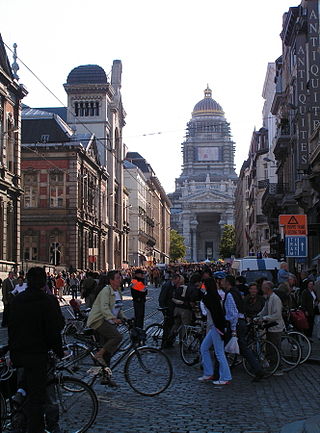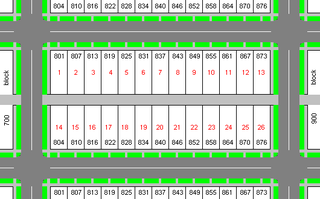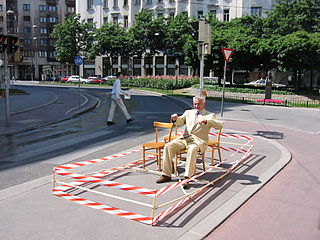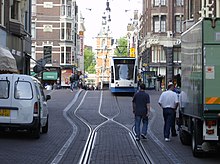
Traffic calming uses physical design and other measures to improve safety for motorists, car drivers, pedestrians and cyclists. It has become a tool to combat speeding and other unsafe behaviours of drivers in the neighbourhoods. It aims to encourage safer, more responsible driving and potentially reduce traffic flow. Urban planners and traffic engineers have many strategies for traffic calming, including narrowed roads and speed humps. Such measures are common in Australia and Europe, but less so in North America. Traffic calming is a calque of the German word Verkehrsberuhigung – the term's first published use in English was in 1985 by Carmen Hass-Klau.

Congestion pricing or congestion charges is a system of surcharging users of public goods that are subject to congestion through excess demand, such as through higher peak charges for use of bus services, electricity, metros, railways, telephones, and road pricing to reduce traffic congestion; airlines and shipping companies may be charged higher fees for slots at airports and through canals at busy times. Advocates claim this pricing strategy regulates demand, making it possible to manage congestion without increasing supply.

Since the start of the twentieth century, the role of cars has become highly important, though controversial. They are used throughout the world and have become the most popular mode of transport in many of the more developed countries. In developing countries, the effects of the car on society are not as visible, however they are nonetheless significant. The development of the car built upon the transport sector first started by railways. This has introduced sweeping changes in employment patterns, social interactions, infrastructure and the distribution of goods.

On car-free days, people are encouraged to travel by means other than cars. Some cities, like Jakarta and Tehran, have weekly car-free days. Other such days are annual. World Car Free Day is celebrated on September 22. Organized events are held in some cities and countries.

Pedestrian zones are areas of a city or town restricted to use by people on foot or human-powered transport such as bicycles, with non-emergency motor traffic not allowed. Converting a street or an area to pedestrian-only use is called pedestrianisation.

The car-free movement is a broad, informal, emergent network of individuals and organizations, including social activists, urban planners, transportation engineers, environmentalists and others, brought together by a shared belief that large and/or high-speed motorized vehicles are too dominant in most modern cities. The goal of the movement is to create places where motorized vehicle use is greatly reduced or eliminated, by converting road and parking space to other public uses and rebuilding compact urban environments where most destinations are within easy reach by other means, including walking, cycling, public transport, personal transporters, and mobility as a service.

A city block, residential block, urban block, or simply block is a central element of urban planning and urban design.

Sustainable transport refers to ways of transportation that are sustainable in terms of their social and environmental impacts. Components for evaluating sustainability include the particular vehicles used for road, water or air transport; the source of energy; and the infrastructure used to accommodate the transport. Transport operations and logistics as well as transit-oriented development are also involved in evaluation. Transportation sustainability is largely being measured by transportation system effectiveness and efficiency as well as the environmental and climate impacts of the system. Transport systems have significant impacts on the environment, accounting for between 20% and 25% of world energy consumption and carbon dioxide emissions. The majority of the emissions, almost 97%, came from direct burning of fossil fuels. In 2019, about 95% of the fuel came from fossil sources. The main source of greenhouse gas emissions in the European Union is transportation. In 2019 it contributes to about 31% of global emissions and 24% of emissions in the EU. In addition, up to the COVID-19 pandemic, emissions have only increased in this one sector. Greenhouse gas emissions from transport are increasing at a faster rate than any other energy using sector. Road transport is also a major contributor to local air pollution and smog.

A living street is a street designed with the interests of pedestrians and cyclists in mind by providing enriching and experiential spaces. Living streets also act as social spaces, allowing children to play and encouraging social interactions on a human scale, safely and legally. Living streets consider all pedestrians granting equal access to elders and those who are disabled. These roads are still available for use by motor vehicles; however, their design aims to reduce both the speed and dominance of motorized transport. The reduction of motor vehicle dominance creates more opportunities for public transportation.

Transportation demand management or travel demand management (TDM) is the application of strategies and policies to increase the efficiency of transportation systems, that reduce travel demand, or to redistribute this demand in space or in time.
A low-emission zone (LEZ) is a defined area where access by some polluting vehicles is restricted or deterred with the aim of improving air quality. This may favour vehicles such as bicycles, micromobility vehicles, (certain) alternative fuel vehicles, hybrid electric vehicles, plug-in hybrids, and zero-emission vehicles such as all-electric vehicles.

Car dependency is the concept that some city layouts cause cars to be favoured over alternate forms of transportation, such as bicycles, public transit, and walking.

Active mobility, soft mobility, active travel, active transport or active transportation is the transport of people or goods, through non-motorized means, based around human physical activity. The best-known forms of active mobility are walking and cycling, though other modes include running, rowing, skateboarding, kick scooters and roller skates. Due to its prevalence, cycling is sometimes considered separately from the other forms of active mobility.
A circulation plan is a schematic empirical projection/model of how people and/or vehicles flow through a given area.

Area C is a congestion charge active in the city center of Milan, Italy. It was introduced in 2012, replacing the previous pollution charge Ecopass and based on the same designated traffic restricted zone. The area is about 8.2 km2 (3.2 sq mi) with 77,000 residents and is accessible through gates monitored by traffic cameras.

The Sustainable Transport Award (STA), is presented annually to a city that has shown leadership and vision in the field of sustainable transportation and urban livability in the preceding year. Nominations are accepted from anyone, and winners and honorable mentions are chosen by the Sustainable Transport Award Steering Committee.

Cars affect many people, not just drivers and car passengers. The externalities of automobiles, similarly to other economic externalities, are the measurable difference in costs for other parties to those of the car proprietor, such costs not taken into account when the proprietor opts to drive their car. According to Harvard University, the main externalities of driving are local and global pollution, oil dependence, traffic congestion and traffic collisions; while according to a meta-study conducted by the Delft University these externalities are congestion and scarcity costs, accident costs, air pollution costs, noise costs, climate change costs, costs for nature and landscape, costs for water pollution, costs for soil pollution and costs of energy dependency.

The green transport hierarchy (Canada), street user hierarchy (US), sustainable transport hierarchy (Wales), urban transport hierarchy or road user hierarchy is a hierarchy of modes of passenger transport prioritising green transport. It is a concept used in transport reform groups worldwide and in policy design. In 2020, the UK government consulted about adding to the Highway Code a road user hierarchy prioritising pedestrians. It is a key characteristic of Australian transport planning.

Mobility transition is a set of social, technological and political processes of converting traffic and mobility to sustainable transport with renewable energy resources, and an integration of several different modes of private transport and local public transport. It also includes social change, a redistribution of public spaces, and different ways of financing and spending money in urban planning. The main motivation for mobility transition is the reduction of the harm and damage that traffic causes to people and the environment in order to make (urban) society more livable, as well as solving various interconnected logistical, social, economic and energy issues and inefficiencies.
Sustainable architecture is a type of architecture with the goal of limiting the environmental impact of a building when compared to regular architecture. Sustainable architecture has become a crucial aspect of modern urban development, with Barcelona at the forefront of this movement. Barcelona, a city already known for its unique architecture, has numerous innovative architectural projects combining cutting-edge design with eco-friendly technologies and materials. Famous architects such as Antoni Gaudí and Enric Ruiz-Geli have used sustainable techniques in their designs, causing Barcelona to be considered sustainably advanced. Barcelona is also working to expand green spaces, public transportation, and use more sustainable energy sources. From residential buildings to public spaces and cultural institutions, Barcelona's sustainable architecture has become a model for sustainable urban development for the rest of the world.


















